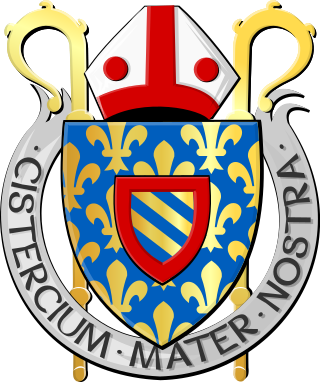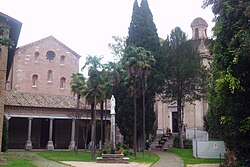
The Cistercians, officially the Order of Cistercians, are a Catholic religious order of monks and nuns that branched off from the Benedictines and follow the Rule of Saint Benedict, as well as the contributions of the highly-influential Bernard of Clairvaux, known as the Latin Rule. They are also known as Bernardines, after Saint Bernard, or as White Monks, in reference to the colour of their cowl, as opposed to the black cowl worn by Benedictines.

Trappist beer is brewed by Trappist monks. Thirteen Trappist monasteries—six in Belgium, two in the Netherlands, and one each in Austria, Italy, England, France, and Spain— produce beer, but the Authentic Trappist Product label is assigned by the International Trappist Association (ITA) to just ten breweries that meet their strict criteria. As of 2021, Achel is no longer recognized as a Trappist brewery because it does not have any monks.

The Trappists, officially known as the Order of Cistercians of the Strict Observance and originally named the Order of Reformed Cistercians of Our Lady of La Trappe, are a Catholic religious order of cloistered monastics that branched off from the Cistercians. They follow the Rule of Saint Benedict and have communities of both monks and nuns that are known as Trappists and Trappistines, respectively. They are named after La Trappe Abbey, the monastery from which the movement and religious order originated. The movement began with the reforms that Abbot Armand Jean le Bouthillier de Rancé introduced in 1664, later leading to the creation of Trappist congregations, and eventually the formal constitution as a separate religious order in 1892.
A commendatory abbot is an ecclesiastic, or sometimes a layman, who holds an abbey in commendam, drawing its revenues but not exercising any authority over its inner monastic discipline. If a commendatory abbot is an ecclesiastic, however, he may have limited jurisdiction.

The Our Lady of Joy Abbey is a monastery at Tai Shui Hang (大水坑), on Lantau Island in the New Territories, Hong Kong. It is home to a number of Roman Catholic monks of the Cistercian Order of the Strict Observance, or Trappists. It was originally named "Trappist Haven Monastery", and founded by refugee monks from Our Lady of Consolation Abbey and Our Lady of Joy Abbey.

The Abbey of Our Lady of Gethsemani is a Catholic monastery in the United States near Bardstown, Kentucky, in Nelson County. The abbey is part of the Order of Cistercians of the Strict Observance, better known as the Trappists. Founded on December 21, 1848, and raised to an abbey in 1851, Gethsemani is considered to be the motherhouse of all Trappist and Trappistine monasteries in the United States. Gethsemani is the oldest Trappist monastery in the country that is still operating.

Farfa Abbey is a territorial abbey in northern Lazio, central Italy. In the Middle Ages, it was one of the richest and most famous abbeys in Italy. It belongs to the Benedictine Order and is located about 60 km (37 mi) from Rome, in the comune (municipality) of Fara Sabina, of which it is also a frazione (hamlet).

Casamari Abbey is a Cistercian abbey in the Province of Frosinone, Lazio, Italy, about 10 kilometers east-south-east of Veroli.

Trois-Fontaines Abbey was a Cistercian abbey in the present commune of Trois-Fontaines-l'Abbaye in the French department of Marne, in the historic province of Champagne.

Santa Maria Scala Coeli is a Roman Catholic Church located on the grounds of the Tre Fontane Abbey located on Via di Acque Salvie 1 in the Quartiere Ardeatino in Rome. This is one of three churches affiliated with the Trappist monastery, and is located on a small lane, Via delle Tre Fontane, inside the abbey complex. The location of this church is held by tradition to be where St Paul the Apostle was imprisoned. on Via delle Tre Fontane in Rome.

Cistercian nuns are female members of the Cistercian Order, a religious order of the Catholic Church.

San Paolo alle Tre Fontane (Italian), in English "St Paul at the Three Fountains" is a Roman Catholic church dedicated to Paul the Apostle, at the presumed site of his martyrdom in Rome. In Latin it is known as Sancti Pauli ad Aquas Salvias. The church located on the grounds of the Tre Fontane Abbey located on Via di Acque Salvie 1 in the Quartiere Ardeatino.

Jean Baptiste de la Barrière was the founder of the reformed Cistercian order, the Feuillants. During his life he became a spiritual adviser to King Henry III of France. During 1587 Henry III built a monastery for the Feuillants to commemorate his friendship with Jean.

La Trappe Abbey, also known as La Grande Trappe, is a monastery in Soligny-la-Trappe, Orne, France. It is known for being the house of origin of the Trappists, to whom it gave its name.

The Feuillants were a Catholic congregation originating in the 1570s as a reform group within the Cistercians in its namesake Les Feuillants Abbey in France, which declared itself an independent order.

The Abbey of Saint Scholastica, also known as Subiaco Abbey, is located just outside the town of Subiaco in the Province of Rome, Region of Lazio, Italy; and is still an active Benedictine abbey, territorial abbey, first founded in the 6th century AD by Saint Benedict of Nursia. It was in one of the Subiaco caves that Benedict made his first hermitage. The monastery today gives its name to the Subiaco Congregation, a grouping of monasteries worldwide that makes up part of the Order of Saint Benedict.

Igny Abbey or Val d'Igny Abbey is a Cistercian abbey located in Arcis-le-Ponsart, Marne, France. It was founded in 1128 for Cistercian monks, dissolved in 1791 during the French Revolution, re-established in 1876 for Trappist monks, destroyed in 1918, reopened in 1929 for Trappist nuns and modernised in 2008–12 to accommodate three or four pre-existing communities.

Mogiła Abbey is a Cistercian monastery in the Nowa Huta District of Kraków, Poland. The abbey was founded in 1222 by the Bishop of Kraków, Iwo Odrowąż. The religious complex was built for religious reasons as well as for prestige. It was the largest and most impressive church in medieval Poland after Wawel Cathedral, and served as the Odrowąż family's burial place until the 16th century.

Morimondo Abbey is a former Cistercian monastery located at Morimondo, a few kilometers south of Abbiategrasso in the Metropolitan City of Milan, Lombardy, northern Italy. The surviving structure is Romanesque and Gothic. It was founded in 1134 as a daughter house of Morimond Abbey near Dijon, from which it took its name.
























